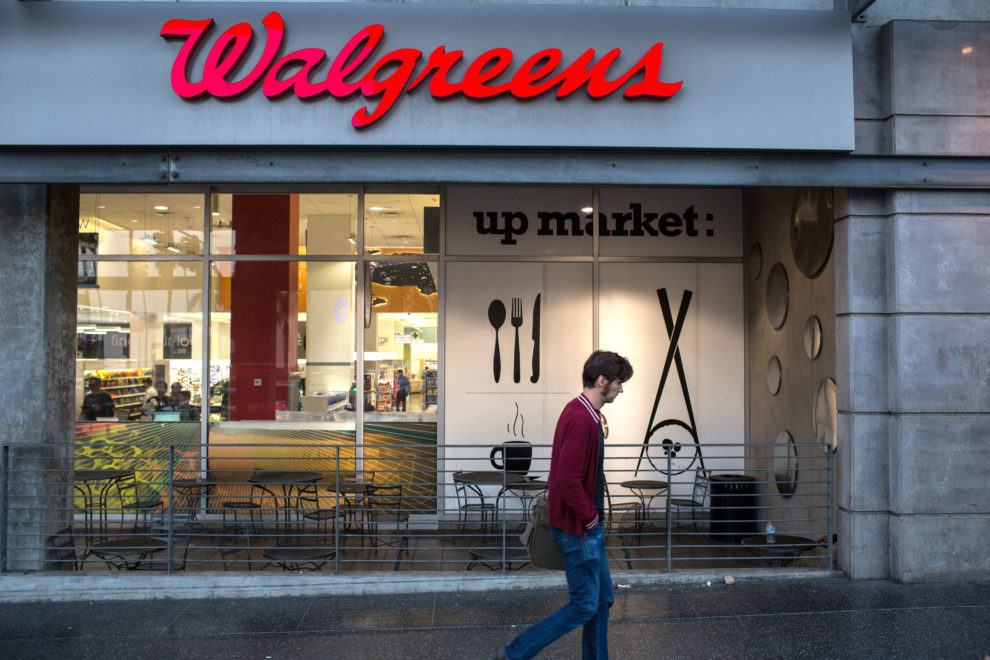
Walgreens Boots Alliance said it saw a surge in sales and then a drop-off in March as the coronavirus pandemic spreads across the world and now keeps people indoors.
The international drugstore’s same-store sales were up 26% in the first 21 days of the month as people stocked up on prescriptions and other items, Global Chief Financial Officer James Kehoe said Thursday on the company’s fiscal second-quarter earnings call. Then, he said, they took a turn and in the last week of March, they were down by the mid-teens.
He said the declines could offset the company’s initial gains, particularly as there’s less foot traffic and fewer sales of discretionary items like beauty products. He said Walgreens can’t provide a reliable outlook for investors about the effects of COVID-19.
Still, Kehoe stressed that Walgreens is prepared and believes sales decreases during the lockdowns are temporary — particularly because the stores sell essential items.
“Our fundamentals are sound and we are convinced we will exit this global crisis in a strong position,” he said.
Walgreens’ earnings call on Thursday provided clues about how retailers still open during the pandemic may fare. The company’s leaders described the complexities of predicting business trends, as customer patterns shift rapidly during a global crisis. For example, they said, some customers bought many months of prescriptions or sought out pharmacists for advice as they prepared for the pandemic. On the other hand, heavily trafficked stores like those on the Las Vegas Strip have been hit hard by closed casinos, restaurants and nearby businesses.
Even the company’s conference call was different, as Walgreens’ top executives dialed in from different locations as they hunkered down and socially distanced from one another.
Walgreens Boots Alliance CEO Stefano Pessina said the drugstore chain has learned from prior challenges, such as the economic downturn of 2008-2009. He said it focused on service and didn’t cut costs significantly then, so it was better prepared to bounce back.
“One of the things that we have learned is that you don’t have to panic,” he said. “You have to accept a certain temporary cost, and keep the organization working.”
But, he acknowledged, there may be a long-term shift in how people shop and how businesses operate if the pandemic is severe for many months.
Walgreens beat Wall Street’s earnings expectations for the quarter. Despite that, its shares were down more than 6% in midmorning trading.
Here’s what Walgreens reported for its fiscal second quarter of 2020 compared with what Wall Street was expecting, based on a survey of analysts by Refinitiv:
- Earnings per share: $1.52 adjusted, vs. $1.46 expected
- Revenue: $35.82 billion, vs. $35.27 billion expected
The global pharmacy chain’s second quarter ended before the number of COVID-19 cases in the U.S. rose significantly and changed customers’ shopping patterns. In recent weeks, however, it has been one of the retailers where customers have gone to stock up on over-the-counter medications, prescriptions and items such as cleaning supplies and disposable gloves.
Kehoe said Walgreens saw increased demand from COVID-19 in the final days of the quarter, but said it did not have a material impact.
In the second quarter ended Feb. 29, net income fell to $946 million, or $1.07 per share, from $1.16 billion, or $1.24 per share, a year earlier.
After adjustments, Walgreens earned $1.52 per share, which was more than the $1.46 per share analysts were expecting, according to Refinitiv.
Walgreens said revenue grew to $35.82 billion, from $34.53 billion last year, and higher than the $35.27 billion analysts expected.
In the quarter, sales at Walgreens’ U.S. retail pharmacy business increased 3.8% to $27.2 billion over the year-ago period. Excluding the impact of leap day, same-store sales rose 2.7% from last year.
Pharmacy sales drove the increase. The company attributed the growth to the larger number of prescriptions it filled and higher drug prices. Same-store pharmacy sales rose 3.7%. Prescriptions filled in comparable stores were up 4.9% from a year ago.
For nonpharmacy products, same-store sales were up by 0.6% in the quarter compared with a year prior. The company attributed the slight growth to sales of health and wellness products during a busy cough, cold and flu season. Excluding tobacco and e-cigarettes, same-store sales of nonpharmacy products increased 1.9%.
In the past week, Walgreens has added new ways for U.S. customers to buy essential items while socially distancing. Customers can now buy more than 60 popular items, such as cleaning supplies, cough and cold medications and formula, at its more than 7,300 pharmacy drive-thrus in the U.S. It also has a partnership with Postmates to make contactless deliveries to customers’ homes.
Its competitor, CVS Health, said it’s seen heightened demand because of the pandemic. It announced plans to fill 50,000 jobs for store associates, home delivery drivers, distribution center employees and customer service professionals.






